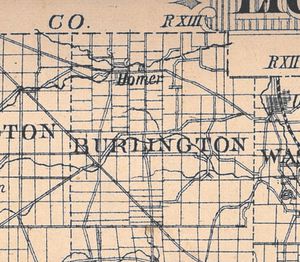Burlington Township
Numerous Native American mounds dotted the township's landscape at the arrival of European settlers. Many of these structures have been lost to agricultural practices, though a striking exception to this destruction is the survival of Dixon Mound in Homer; Dixon Mound, fifteen feet high and eight feet across, stands on private property near the Homer Public Library.
The earliest European settlers arrived in Burlington Township in 1806, and the area was organized as a township in 1817. The village that grew in the township was originally named Burlington as ell, but the name was changed to Homer when a post office was added to the village to avoid confusion with another Burlington in Ohio. [1] The naming of the township is credited to Colonel Wait Wright, an early settler, who promised whiskey to other settlers if he could name the area after his birthplace in Vermont. [2] The township had a population of 1,061 in 1870. [3] The population had changed very little by the 2010 census with only 1,223 inhabitants and the township remains rural and agricultural. [4]
Homer Giant
Around 1824 the inhabitants of Homer unearthed a set of bones near one of the area's many Native American structures; the skeleton was reported to possess a jawbone that "would go over the face of the largest man present, with two hands placed between." [5] Speculation raged that it was the skeleton of a great and powerful chief of an ancient people. In a separate excavation near Homer in 1815, another set of large bones was found which included a tooth around five inches long and a rib bone five feet in length. These discoveries led the local residents to speculate that a race of giants once lived in the area.
Burlington Storm
Nineteenth-century historians of Licking County recorded a severe storm in northern part of Licking County on May 18, 1825. The storm would become known as the "Burlington Storm" and was likely a tornado, or series of tornados and severe storms that ravaged the area. Cutting from Delaware and Knox Counties, through Bennington Township and Burlington Township in Licking, and then into Coshocton, the storm left a swath of devastation in its wake. Trees, buildings, and livestock were severely damaged and harmed. Three people were killed by the tornado, including a son of Colonel Wright and two members of the Vance family after their farms were hit by the storm. A young eyewitness, twelve-year-old Sarah Robb, was reportedly carried more than a hundred yards by the winds and set down with nothing more than bruises. [6]
J.G.
References
- ↑ Combination Atlas Map of Licking County, Ohio, ed., Everts, L.H., (1875), 29
- ↑ Hill, N., History of Licking County, Ohio., Its Past and Present, (1881), 405
- ↑ Smucker, I., Centennial History of Licking County, Ohio, (1876), 23
- ↑ https://lickingcounty.gov/civicax/filebank/blobdload.aspx?BlobID=49093
- ↑ Brister, E., Centennial History, (1909) 344
- ↑ Smucker, I., Centennial History of Licking County, Ohio, (1876), 54
